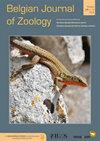Coral reef fish communities of natural habitats and man-made coastal structures in Bora-Bora (French Polynesia)
IF 1.1
4区 生物学
Q2 ZOOLOGY
引用次数: 0
Abstract
Coastal habitats have long been recognised to be nurseries and growing grounds for many marine organisms. Worldwide, coastal hardening and urbanisation are leading to the removal of natural ecosystems. The tropical island of Bora-Bora in the South Pacific has undergone extensive coastal changes, with the construction of seawalls along more than half of its coastline since the 1950s. The daytime and night-time juvenile and adult fish communities were surveyed with multiple temporal replicates on a range of lagoon and coastal habitats on Bora-Bora. Over 47% of all fish on coastal habitats were juveniles. Mangroves, traditionally viewed as nurseries, had a high daytime and night-time abundance of juveniles, but less than 1% of the coastline of Bora-Bora consists of mangroves. The manmade seawalls, which are the most common type of coastal habitat on the island, were associated with lower juvenile densities during the day and promoted the presence of predators. The comparison of coastal and lagoon sites also highlighted contrasting life history strategies depending on coral reef fish species: although many favour coastal habitats as juveniles, others do not undergo ontogenetic shifts and thus other habitats must be considered when designing management plans to protect juvenile fish. Overall, our surveys show the importance of natural coastal zones in the lifecycle of numerous coral reef fish species in the lagoon of Bora-Bora and highlight the potential long-term impacts of coastal hardening on fish communities.波拉-波拉岛(法属波利尼西亚)自然生境和人工海岸结构的珊瑚礁鱼类群落
沿海栖息地长期以来被认为是许多海洋生物的苗圃和生长地。在世界范围内,海岸硬化和城市化正在导致自然生态系统的消失。南太平洋的热带岛屿波拉波拉岛经历了广泛的海岸变化,自20世纪50年代以来,其一半以上的海岸线都修建了海堤。对波拉-波拉岛一系列泻湖和海岸生境的白天和夜间幼鱼和成鱼群落进行了多次时间重复调查。超过47%的沿海鱼类是幼鱼。红树林,传统上被视为苗圃,在白天和晚上都有大量的幼鱼,但只有不到1%的波拉波拉岛海岸线上有红树林。人造海堤是岛上最常见的沿海栖息地类型,白天的幼鱼密度较低,并促进了捕食者的存在。沿海和泻湖地点的比较也突出了依赖于珊瑚礁鱼类物种的不同生活史策略:尽管许多鱼类在幼年时喜欢沿海栖息地,但其他鱼类没有经历个体发生的变化,因此在设计保护幼鱼的管理计划时必须考虑其他栖息地。总的来说,我们的调查显示了自然海岸带在波拉波拉泻湖众多珊瑚礁鱼类生命周期中的重要性,并强调了海岸硬化对鱼类群落的潜在长期影响。
本文章由计算机程序翻译,如有差异,请以英文原文为准。
求助全文
约1分钟内获得全文
求助全文
来源期刊

Belgian Journal of Zoology
生物-动物学
CiteScore
1.90
自引率
0.00%
发文量
10
审稿时长
>12 weeks
期刊介绍:
The Belgian Journal of Zoology is an open access journal publishing high-quality research papers in English that are original, of broad interest and hypothesis-driven. Manuscripts on all aspects of zoology are considered, including anatomy, behaviour, developmental biology, ecology, evolution, genetics, genomics and physiology. Manuscripts on veterinary topics are outside of the journal’s scope. The Belgian Journal of Zoology also welcomes reviews, especially from complex or poorly understood research fields in zoology. The Belgian Journal of Zoology does no longer publish purely taxonomic papers. Surveys and reports on novel or invasive animal species for Belgium are considered only if sufficient new biological or biogeographic information is included.
 求助内容:
求助内容: 应助结果提醒方式:
应助结果提醒方式:


